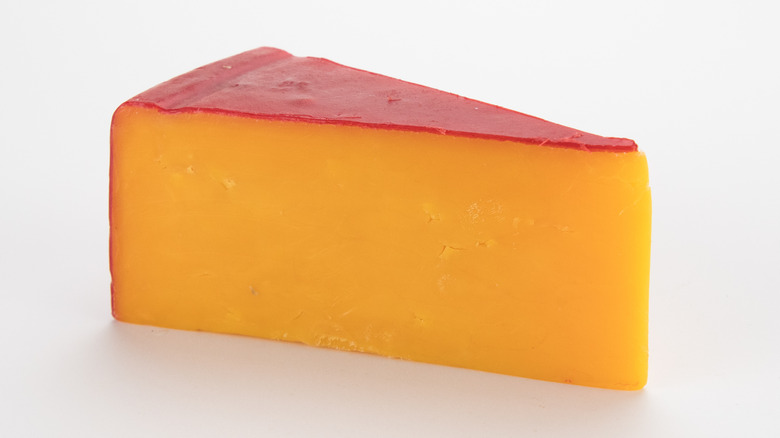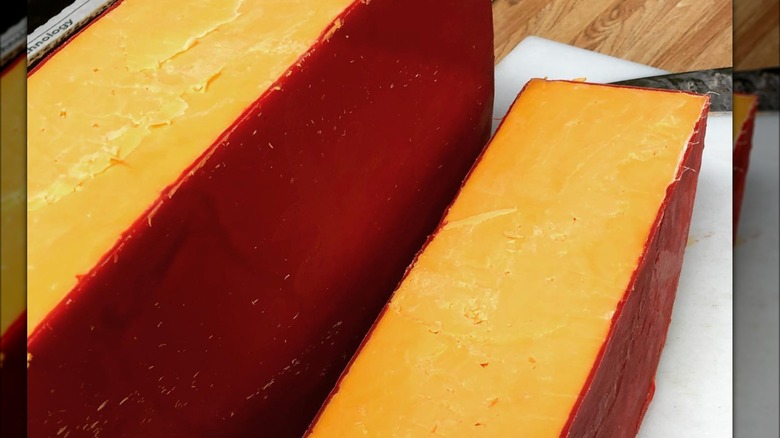What Exactly Is Hoop Cheese And How Did It Get Its Name?
If you're from the American South or Midwest, you may have heard of hoop cheese, as the red wax-covered wheel of cheese was a familiar sight in general stores and mom-and-pop shops from the 19th century to the mid-20th century. Hoop cheese is made from cow's milk and cow's milk only, with nothing else added. The absence of additives such as salt greatly shortened the cheese's shelf life expectancy down to only one or two weeks.
The bland, semisoft cheese was also called red ring or red rind cheese because the wax used to encase the cheese was typically red, which indicated a milder-tasting cheese. So-called "black rind" hoop cheese had a sharper taste, hence the use of black wax. Softer varieties of hoop cheese, called baker's cheese, were often used in recipes for baked goods.
Although widely available in the South, Midwest, and Texas, hoop cheese had a few characteristics that kept it from being successfully mass-produced and sold. Its short shelf life and fairly neutral flavor made cheesemakers consider hoop cheese to not be worth the effort to try to mass produce, pretty much ensuring that hoop cheese would remain a nostalgic food for Southerners with fond memories of buying fresh hoop cheese from a local farmer at the community store.
Characteristics of hoop cheese
But how did a simple cow's milk cheese get such an interesting name? The name is a nod to how the cheese is made and looks. Hoop cheese is made by heating raw milk, draining the whey from the curd, and then pressing the curds tightly together in the hoop mold to create one large hoop-shaped wheel of cheese. A wax rind was added to seal it all up. At first glance, hoop cheese looks similar to cheddar but has distinctive characteristics that set it apart. Hoop cheese is a semi-hard cheese with a crumbly texture and a mostly mild flavor often described as nutty, buttery, and creamy.
The creaminess is one of the main selling points of hoop cheese. Hoop cheese's fairly neutral taste allows it to pair well with many other ingredients and help those flavors stand out. Southern cuisine gets creative with fresh cheese, going beyond the cheese plate to compose dishes where hoop cheese elevates a dish with its creaminess, or tones down the sharpness when combined with a cheddar. The qualities of hoop cheese can also be greatly impacted by the cows' diet and preparation methods which can vary by region.
How to eat and serve hoop cheese
Hoop cheese was popular in the American South and Midwest as a traditional food first made on homesteads and small farms. Beginning in the early 1900s, hoop cheese became a fixture in local grocery stores. Today, you're most likely to find hoop cheese at specialty cheese shops, local farmer's markets, and online. Some small, locally owned general stores in the South still offer hoop cheese in-store or online.
Hoop cheese is versatile — you can enjoy it with crackers and fruit, and also cook and bake with it. The semi-soft cheese melts beautifully, imparting dishes with a milk creaminess that mellows out the sharper bite of stronger ingredients. You can use hoop cheese at home in almost any recipe that calls for melted cheese, including traditional Southern favorites that connect hoop cheese with its roots. Melt cheese into grits, mix it into biscuit dough, or grate a wedge of hoop cheese for homemade cheese straws. Take advantage of hoop cheese's creamy texture and neutral taste by pairing it with sweet fruits like berries for dessert, or incorporating it into a casserole. A new world of creamy goodness awaits in this traditional Southern cheese that tastes like nostalgia.


